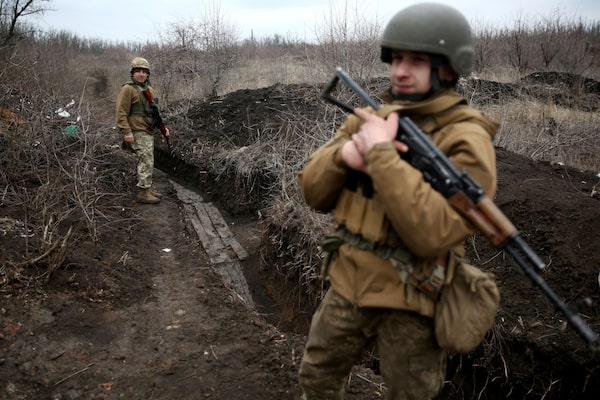
Ukrainian servicemen patrol along fighting positions on the front line with Russia-backed separatists near the town of Avdiivka in Donetsk region on April 5, 2021.STR/AFP/Getty Images
Ukraine is looking to Ottawa for help in persuading the NATO military alliance to set it on a path to membership, a campaign Kyiv is pursuing as a Russian military buildup takes shape near its eastern borders.
Ukraine’s President, Volodymyr Zelensky, spoke with Prime Minister Justin Trudeau Tuesday, and Ukraine’s ambassador to Canada told The Globe and Mail that “an important part of the conversation” was about Kyiv’s drive for NATO membership.
The private phone call came the same day Mr. Zelensky publicly urged NATO to lay out a path for Ukraine to join the alliance.
“NATO is the only way to end the war in Donbass,” Mr. Zelensky told NATO Secretary-General Jens Stoltenberg in a phone call, according to a statement from the President’s office.
A Membership Action Plan (MAP) laying out Ukraine’s entry path into the alliance “will be a real signal for Russia,” Mr. Zelensky said.
Andriy Shevchenko, Kyiv’s ambassador to Canada, said in an interview that while he wasn’t party to the Trudeau-Zelensky conversation, Ukraine is asking the Canadian government for help persuading other NATO members to agree to a MAP for Kyiv.
“We count on Canada in supporting us in getting [the] Membership Action Plan,” Mr. Shevchenko said.
A NATO MAP doesn’t guarantee future membership, but it’s a mechanism that puts countries on a track to membership. It sets out standards countries must meet as they prepare for inclusion.
As the Ukraine ambassador explained MAP: “Once you are there, you pretty much know where this escalator is going to take you.”
“Canada has been supportive of our NATO ambitions so far. We would even ask for more. We would ask Canada to get this knowledge to other, maybe more skeptical partners inside of the alliance,” the envoy said.
He said Ukraine is grateful for all of Canada’s help to date, including being the first Western country to recognize Ukraine’s independence after leaving the Soviet Union in 1991. Ukraine is the ancestral homeland of about 1.4 million Canadians.
“Now we expect Canada to help us to build good communication with all the NATO members and we hope Canada will help us to get Membership Action Plan and it will help us to become a formal NATO member with all the benefits that we can bring into the alliance.”
Since late March, Russia has been massing troops on its side of the Russian-Ukraine border near the eastern Ukraine Donbass region, where Kyiv has been fighting Moscow-backed separatists since 2014. That same year, Russia seized and annexed Ukraine’s Crimean Peninsula. Ukraine estimates that 14,000 people have been killed in the Donbass conflict including 24 Ukrainian soldiers this year.
The Kremlin has said that Russian military movements near its shared border with Ukraine posed no threat to Ukraine or anyone else and that Moscow moved troops around its country as it saw fit.
The Canadian Armed Forces has been training Ukrainian troops in Ukraine since 2015 to help Kyiv fight Russian-backed rebels in the Donbass. Canada’s Operation Unifier mission, involving about 200 Canadian troops, is now in seven locations around Ukraine, including Odessa on the Black Sea.
Mr. Shevchenko said he believes Canada’s experience training Ukraine soldiers has well positioned it to sell other NATO members on Ukraine’s membership.
The Ukraine ambassador said Kyiv is very concerned about the Russian military buildup, which he said has been accompanied by a rise in propaganda from Russia. Ukrainian officials do not believe this is merely a Russian training exercise.
“We see clear signs they are preparing their domestic population for major military activities against Ukraine,” Mr. Shevchenko said.
He said one theory is that Moscow is testing the resolve of new U.S. President Joe Biden’s administration, as well as how Ukraine’s allies respond to the threat.
But he said regardless, Ukraine needs a strong response from its friends and allies.
“One way or another: whether it’s a test or whether it’s an actual preparation, we believe the consolidated co-ordinated reaction of the free world should be very firm, very clear and very strong.”
Ukraine’s territorial dispute with Russia could be a stumbling block for NATO membership. A 1995 NATO study that laid out guidelines for enlarging membership says prospective members must settle disputes peacefully and that “resolution of such disputes would be a factor in determining whether to invite a state to join the Alliance.”
Mr. Shevchenko said he considers this to be an academic question and said he believes there are no formal rules barring admission of a new member with an ongoing territorial dispute.
“I think there is a growing consensus in the West and inside of NATO that the aggression of the Russian federation is not an obstacle but is probably rather another reason to consider strongly full speed on advancing toward a Membership Action Plan,” he said.”
“We in Ukraine already consider Ukraine a de facto Eastern flank of NATO.”
Fen Hampson, a professor of international affairs at Carleton University in Ottawa, said Ukraine’s campaign strikes him as a “plea for help” but said NATO would be extremely hesitant to give Kyiv membership because it could provoke Russia aggression.
“If there was appetite to put Ukraine in NATO it would have happened by now.”
The Prime Minister’s Office declined to comment on the Ukraine ambassador’s statement. Earlier Tuesday, Mr. Trudeau told reporters during his call with Mr. Zelensky that he reaffirmed “Canada’s unwavering support for Ukraine’s sovereignty and territory integrity, as well as our commitment to further deepening our long-standing friendship with Ukraine.”
With reports from Reuters
Know what is happening in the halls of power with the day’s top political headlines and commentary as selected by Globe editors (subscribers only). Sign up today.
 Steven Chase
Steven Chase